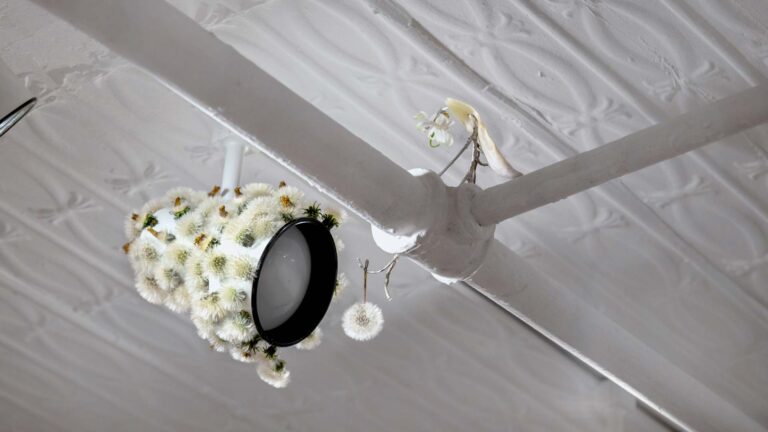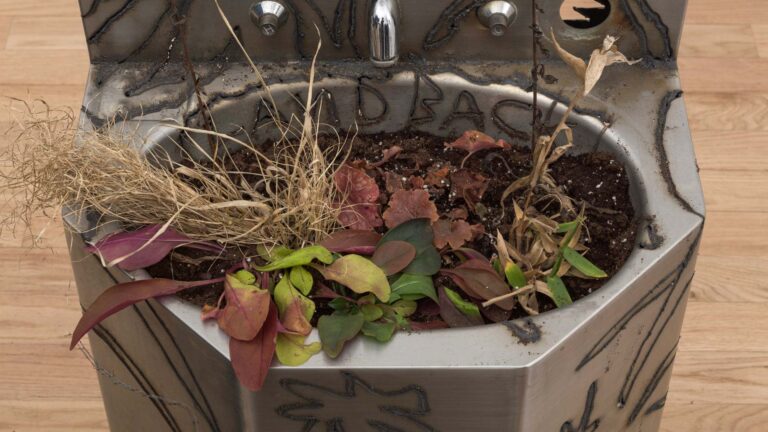Artist: Vikky Alexander
Exhibition title: 1981–1983
Venue: Tara Downs, New York, US
Date: February 10 – March 12, 2017
Photography: all images copyright and courtesy of the artist and Tara Downs, New York
Representation, then, is not—nor can it be—neutral; it is an act—indeed the founding act—of power in our culture.
—Craig Owens
Vikky Alexander is often introduced as a sleeper Pictures Generation artist, though she never seamlessly fit into that mostly male circle. Active in New York in the early 1980s, Alexander appropriated commercial photography, her work blowing up cropped images of actresses and models from magazine campaigns. “Entertainment” (1983), for example, juxtaposes four enlarged images from a fashion spread: a cropped leg that appears conspicuously as big as the model’s nearby arm, a heavily made-up woman looking over her shoulder, and a pair of feet mirroring each other, creating a wide tunnel. Above these images, the word “entertainment” is writ large and points to the role of the passive female body as a consumable site of pleasure within these images.
While Alexander showed with Pictures artists in venues such as The Barbican, Dia Art Foundation, ICP, Kunsthalle Bern, White Columns, and the Whitney Museum, she was a decade younger than most involved in the movement. Further marking her apart from her peers, she came to New York fresh from university at Nova Scotia College of Art and Design, bypassing the American conceptual schools that many Pictures artists attended. Like Pictures artists such as Jack Goldstein and Troy Brauntuch, Alexander collaged mass media imagery within her own practice. Yet perhaps uniquely, her work highlighted the relationship between the viewer’s body and the framed photograph. Brazenly elevating a fashion ad to the nobility of a masterpiece is her work “Pieta” (1981), which takes its name from the Michelangelo sculpture that depicts Jesus on the lap of Mary after his crucifixion. Alexander’s version, a gender reversal of the classical sculpture, blows up a fashion campaign featuring a coiffed blonde male model looking down at a woman in a soft embrace. The image is framed within a black, figure-sized matt and a sheet of highly reflective Plexiglas. Walking up to the work, the viewer notices their reflection, superimposing their own everyday image with that of the “ideal” model. Similarly, “Ecstasy” (1982) references the baroque marble sculpture “The Ecstasy of St. Theresa” (1647-52) by Gian Lorenzo Bernini, and as such features repeating images of a seemingly orgasmic Isabella Rosselini. Characteristically, Alexander framed these successive images in a long rectangular formation with highly reflective Plexiglas covering a black matt. The repeated imagery and historical reference signifies a continuum; in knowing contrast with the distinctiveness of its format, it calls upon an archetype that recurs ad inifinitum throughout time.
Also visible in these works due to the extreme enlargement of their source material is the images’ photo grain, highlighting the materiality of the analog photograph as a medium. Alexander was erstwhile deeply invested in the ongoing debate about the legitimacy of photography as a fine art medium capable of creating conceptual, rather than solely documentarian, meaning. Perhaps more telling than her association with Pictures is Alexander’s allegiance to a movement of feminist appropriation artists that comparatively has not been as forcefully narrativized. In addition to Alexander, this often-overlooked canon includes Sherrie Levine, Dara Birnbaum, Barbara Kruger and Martha Rosler, among others, all of whom have highlighted the jarring fracture between the lived experience of the female body and its idealized presentation in the media as a point of focus for photography amid its ongoing reimagining as a fine art medium.
Alexander’s feminism is a reflective one that quietly explicates the power of framing devices in the representation of women. Her works “Portage Glacier” (1983) and “Yosemite” (1982) splice images of models into sublime natural landscapes sourced from calendars. “Portage Glacier” features a monochromatic image of a woman’s face flanked by an arctic landscape, while “Yosemite” inserts a glamor shot of a big-haired model zipping up her coat between two images of a mountainous forest canon. Convening idealized images of both women and majestic landscapes suggests that the sublime power of such beauty is one that cultures the world over have felt the need to protect, sometimes as a legitimization of violence.
Though Alexander’s work touches on incredibly thorny subject matter, it also calls on a nuanced sense of humor. Her work “Sleep” (1983), a reference to Michelangelo’s sculpture “The Night,” features two women posing as if they’re sleeping, though in reality the models appear again heavily made-up and politely orgasmic—anything but actually unconscious. Sleep, after all, is the only living state in which we are unable to perform gender and class codes, temporarily suspending this performance along with bodily awareness. Alexander’s signature black matting again prompts the viewer to consider their physicality in relation to the absurd expectation of being both sexually available and asleep. While the media has rapidly evolved in the decades since this series was created, Alexander’s fundamental queries remain extraordinarily relevant: how am I reflected in the media, and how does the media reflect back upon me?
–Karen Archey
Vikky Alexander (b. 1959, Victoria, Canada) is a graduate of the Nova Scotia College of Art and Design. Her practice has been presented in venues including White Columns, New Museum, The Whitney Museum of American Art, Dia Art Foundation, Seattle Art Museum, Kunsthalle Bern, International Center of Photography, Vancouver Art Gallery, Cooper Cole Gallery, National Gallery of Canada, Barbican Art Gallery, Yokohama Civic Art Gallery, and Taipei Fine Arts Museum, amongst others. Her works are included in the collections of the Los Angeles Museum of Contemporary Art, International Center of Photography, National Gallery of Canada, and the Deste Foundation, among others. She lives and works in Montreal, Canada.
Vikky Alexander, 1981-1983, 2017
Installation view (Eldridge), Downs & Ross, New York
Vikky Alexander, Ecstasy, 1982, Type R prints, 24 x 102.75 inches / 60.96 x 260.98 cm (framed), Edition of 2 plus A/P
Vikky Alexander, Ecstasy, 1982 (detail), Type R prints, 24 x 102.75 inches / 60.96 x 260.98 cm (framed), Edition of 2 plus A/P
Vikky Alexander, Ecstasy, 1982 (detail), Type R prints, 24 x 102.75 inches / 60.96 x 260.98 cm (framed), Edition of 2 plus A/P
Vikky Alexander, Ecstasy, 1982 (detail), Type R prints, 24 x 102.75 inches / 60.96 x 260.98 cm (framed), Edition of 2 plus A/P
Vikky Alexander, 1981-1983, 2017
Installation view (Eldridge), Downs & Ross, New York
Vikky Alexander, Pieta, 1981, Chromogenic color prints, 65 x 27 inches / 165.1 x 68.58 cm (framed), Unique plus A/P
Vikky Alexander, 1981-1983, 2017
Installation view (Eldridge), Downs & Ross, New York
Vikky Alexander, 1981-1983, 2017
Installation view (Chrystie), Downs & Ross, New York
Vikky Alexander, Sleep, 1983, Digital print on Moab Slickrock Argent acid-free paper mounted on Dibond, 15 x 60 inches / 38.1 x 152.4 cm (framed), Edition of 2 plus 2 A/P
Vikky Alexander, 1981-1983, 2017
Installation view (Chrystie), Downs & Ross, New York
Vikky Alexander, Portage Glacier, 1982, Digital print on Moab Slickrock metallic pearl acid-free paper mounted on Dibond, 18 x 40 inches / 45 x 101.6 cm (framed), Edition of 3 plus AP
Vikky Alexander, 1981-1983, 2017
Installation view (Chrystie), Downs & Ross, New York
Vikky Alexander, Entertainment, 1983, Chromogenic color prints mounted on acid-free museum board, 35.5 x 135.25 inches / 90.17 x 343.54 cm (framed), Unique plus A/P
Vikky Alexander, Entertainment, 1983 (detail), Chromogenic color prints mounted on acid-free museum board, 37.25 x 137 inches / 94.62 x 347.98 cm (framed), 25.25 x 37.25 inches / 64.14 x 94.62 cm (single frame above), Unique plus A/P
Vikky Alexander, Entertainment, 1983 (detail), Chromogenic color prints mounted on acid-free museum board, 35.5 x 135.25 inches / 90.17 x 343.54 cm (framed), 37.25 x 25.25 inches / 94.62 x 64.14 cm (single frame above), Unique plus A/P
Vikky Alexander, Entertainment, 1983 (detail), Chromogenic color prints mounted on acid-free museum board, 35.5 x 135.25 inches / 90.17 x 343.54 cm (framed), 37.25 x 25.25 inches / 94.62 x 64.14 cm (single frame above), Unique plus A/P
Vikky Alexander, Entertainment, 1983 (detail), Chromogenic color prints mounted on acid-free museum board, 35.5 x 135.25 inches / 90.17 x 343.54 cm (framed), 37.25 x 25.25 inches / 94.62 x 64.14 cm (single frame above), Unique plus A/P
Vikky Alexander, 1981-1983, 2017
Installation view (Chrystie), Downs & Ross, New York
Vikky Alexander, Yosemite, 1982, Digital print on moab slickrock metallic pearl acid-free paper mounted on Dibond, 22 x 40 inches / 55.88 x 101.6 cm (framed), 21.5 x 39.75 inches / 54.61 x 100.97 cm (unframed), Edition of 3 plus AP

























